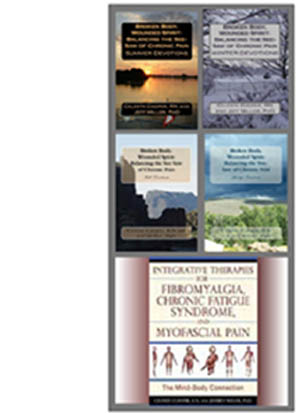Myofascial trigger points can mimic many things and cause pain, dysfunction, and shortening of the muscle affected by this knotted up muscle fiber in a taut band of muscle. Such things as paresthesias (numbness and tingling that can be local or radiate in a specific pattern), burning, and pain can result from a MTrP, which is entrapping a nerve. Circulation/temp changes can occur if a MTrP is located next to a blood vessel, and swelling can develop if the MTrP is located next to a blood or lymph vessel). (Helpful treatments are links following).
The following book excerpts are protected by copyright, you must ask permission from Healing Arts Press to reuse this content.
Common Abbreviations©
MPS: myofascial pain syndrome
CMP: chronic myofascial pain
MTP: myofascial trigger point
TrP: trigger point
Myofascial Trigger Point©
A myofascial trigger point (TrP) is a self-sustaining, irritable area in the muscle that can be felt as a nodule in a taut band. This irritated spot causes the muscle to gradually shorten, interfering with the motion function of the muscle and causing weakness and pain. Trigger points differ from tender points in that generally they refer pain to other parts of the body and can usually be felt with the hand (palpated) unless the muscle is too rigid from intense muscle involvement, or the trigger point is in a deep muscle or under bone. The tender points of FM or myalgias associated with CFID do not restrict motion or cause localized muscle weakness. If they do, the patient should also be evaluated for the presence of CMP. Trigger points in CMP are well defined and often radiating—the pain radiates out to other parts of the body.
Active Trigger Point©
An active TrP is a myofascial trigger point that causes pain at rest. It is always tender, causes shortening of the muscle, weakens the muscle, and causes patient complaints of referred pain on direct compression. An active trigger point can elicit a visible local twitch response when adequately stimulated by compression or needle insertion. It can produce referred motor and autonomic phenomena, generally occurring in the TrP referral zone. An active TrP can also cause the referral zone to become tender.
Secondary Trigger Point©
A secondary TrP is one that develops in a second compensating muscle. A compensating muscle is one that is trying to make up for the malfunction of the muscle affected by primary trigger points. In other words, when a primary trigger point causes muscle dysfunction, the opposing muscles become stressed. These opposing muscles become overloaded because they are attempting to carry the entire load of the muscle work needed to perform a task. When staring at a computer screen your head starts to drift forward after a while, particularly if you spend hours there. You may have primary TrPs in muscles on the front of your neck, which may or may not be making their presence known. As your head starts drifting forward, putting less stress on the primary TrPs because of the slackening, the muscles on the backside of your neck are being stretched and stressed in an effort to keep your face from falling onto your keyboard. The sustained overstretching of these muscles causes secondary trigger points to develop in the muscles on the back of your neck. (This is an important reason to pay attention to posture as an aggravating factor, to be discussed in chapter 4.)
Satellite Trigger Point©
Chronic myofascial pain (CMP) from myofascial trigger points is a peripheral nerve to muscle problem. Acetylcholine (a neurotransmitter, a chemical that carries information from the peripheral nervous system to the central nervous system) has been found in excessive amounts. Fibromyalgia, CFID/ME, migraine, IBS, irritable bladder and several other common co-existing conditions have a strong central nervous system component. When any of these co-exist with chronic myofascial pain (CMP) from myofascial trigger points (TrPs), the peripheral message of painful trigger points to the brain keeps the brain in a hypersensitive state," causing a “wind up” phenomenon at the HPA-axis (dysfunctional in FM and thought to be dysfunction in CFID) is off an running.
End Comments:
Chronic myofascial pain (CMP) from myofascial trigger points is a peripheral nerve to muscle problem. Acetylcholine (a neurotransmitter, a chemical that carries information from the peripheral nervous system to the central nervous system) has been found in excessive amounts where nerve meets muscle. Biopsies show a histological difference in MTrP fiber and even differences between an active and latent MTrP. Because of development of new technology examiners can now easily locate MTrPs for treatment.
Fibromyalgia, CFID/ME, migraine, IBS, irritable bladder and several other common co-existing conditions have a strong central nervous system component. When any of these co-exist with chronic myofascial pain (CMP) from myofascial trigger points (TrPs), the peripheral message of painful trigger points to the brain keeps the brain in a hypersensitive state," causing a “wind up” phenomenon at the HPA-axis (dysfunctional in FM and thought to be dysfunction in CFID) is off an running.
Myofascial trigger points can mimic sciatica, pelvic floor pain, or costochondritis. They can also cause painful intercourse, impotence, vulvodynia, cavitational necrosis, TMJ/TMD, restless leg syndrome, PMS, and much more. They can be one of the main factors in migraine headaches, chronic sinusitis and a host of other conditions. They are NOT to be taken lightly, especially now with abounding and repeated research over more than a decade showing us that they are a main component in the pain of FM.
Myofascial Release http://www.myofascialrelease.com/fascia_massage/public/default.asp
Active Release Therapy (ART) http://www.qfac.com/pain_management/active_release_therapy.html
National Association of Myofascial Trigger Point Therapists http://www.myofascialtherapy.org
Recommended reading for self treatment:
Integrative Therapies for Fibromyalgia, Chronic Fatigue Syndrome and Myofascial Pain: The Mind-Body Connection by Celeste Cooper, RN and Jeff Miller, PhD. Healing Arts Press: Vermont, 2010. (Forward by Devin Starlanyl, author, researcher, endorsed by Dr. John Whiteside, myofascial and holistic specialist physician, Australia, and Bill Douglas, Best Selling author, teacher, and founder of many stress management programs with global recognition.)
Healing Arts Press (Publisher)
http://store.innertraditions.com/isbn/978-1-59477-323-5 (On Sale)
Amazon
http://www.amazon.com/Integrative-Therapies-Fibromyalgia-Syndrome-Myofascial/dp/1594773238/ref=sr_1_1?ie=UTF8&s=books&qid=1246252159&sr=8-1(available in Kindle)
Barnes and Nobel
http://search.barnesandnoble.com/Integrative-Therapies-for-Fibromyalgia-Chronic-Fatigue-Syndrome-and-Myofascial-Pain/Jeffrey-Miller/e/9781594773235?itm=1&USRI=Integrative%20Therapies%20for%20Fibromyalgia,%20Chronic%20Fatigue%20Syndrome,%20and%20Myofascial%20Pain:%20The%20Mind-Body
The Trigger Point Therapy Workbook, 2nd ed. By Clair Davies, NCTMB with Amber Davies, NCTMB. New Harbinger: Oakland, 2004. (Forward by Dr. David Simons)
http://www.triggerpointbook.com/triggerp.htm
Amazon
http://www.amazon.com/Trigger-Point-Therapy-Workbook-Self-Treatment/dp/1572243759/ref=sr_1_1?ie=UTF8&qid=1307195480&sr=8-1
Barnes and Nobel
http://www.barnesandnoble.com/w/trigger-point-therapy-workbook-2d-clair-davies/1006105335
I hope you found this information helpful.
"Though our bodies are weak our determination is unbreakable, standing tall, standing strong, standing united, committing to a cure."
Celeste http://TheseThree.com
Resources:
Ashkenazi A, Blumenfeld A, Napchan U, Narouze S, Grosberg B, Nett R, DePalma T, Rosenthal B, Tepper S, Lipton RB. Peripheral nerve blocks and trigger point injections in headache management - a systematic review and suggestions for future research. Headache. 2010 Jun;50(6):943-52. Epub 2010 May 7.
Cakit BD, Taskin S, Nacir B, Unlu I, Genc H, Erdem HR.Comorbidity of fibromyalgia and cervical myofascial pain syndrome. Clin Rheumatol. 2010 Apr;29(4):405-11.
Cooper, C and Miller, J. (2010). Integrative Therapies for Fibromyalgia, Chronic Fatigue Syndrome and Myofascial Pain: The Mind-Body Connection. Healing Arts Press: Vermont
Fernández-de-las-Peñas C, Galán-del-Río F, Fernández-Carnero J, Pesquera J,
Arendt-Nielsen L, Svensson P. Bilateral widespread mechanical pain sensitivity in women with myofascial temporomandibular disorder: evidence of impairment in central nociceptive processing. J Pain. 2009 Nov;10(11):1170-8. Epub 2009 Jul 9.
Ge HY.Prevalence of myofascial trigger points in fibromyalgia: the overlap of two common problems.Curr Pain Headache Rep. 2010 Oct;14(5):339-45.
Ge HY, Fernandez-de-Las-Penas C, Yue SW, Myofascial trigger points: spontaneous electrical activity and its consequences for pain induction and propagation. Chin Med. 6(1):13, 2011.
Ge HY, Nie H, Madeleine P, Danneskiold-Samsøe B, Graven-Nielsen T, Arendt-Nielsen
L. Contribution of the local and referred pain from active myofascial trigger points in fibromyalgia syndrome. Pain. 2009 Dec 15;147(1-3):233-40. Epub 2009 Oct 9.
Ge HY, Zhang Y, Boudreau S, Yue SW, Arendt-Nielsen L. Induction of muscle cramps by nociceptive stimulation of latent myofascial trigger points. Exp Brain Res. 2008 Jun;187(4):623-9. Epub 2008 Mar 4.
Giamberardino MA, Affaitati G, Fabrizio A Costantini R. Effects of Treatment of Myofascial Trigger Points on the Pain of Fibromyalgia. Curr Pain Headache Rep. [May 5 Epub ahead of print].
Gerwin R. Treatment of Chronic Migraine Headache with nabotulinumtoxinA Curr Pain Headache Rep. 2011 May 6. [Epub ahead of print]
Hubbard JE. Myofascial trigger points. What physicians should know about these neurological imitators. Minn Med. 2010 May;93(5):42-5.
Niddam DM, Chan RC, Lee SH, Yeh TC, Hsieh JC. Central representation of hyperalgesia from myofascial trigger point. Neuroimage. 2008 Feb 1;39(3):1299-306. Epub 2007 Oct 11.
Niddam DM. Brain manifestation and modulation of pain from myofascial trigger points. Curr Pain Headache Rep. 2009 Oct;13(5):370-5.
Partanen JV, Ojala TA, Arokoski JP. Myofascial syndrome and pain: A neurophysiological approach. Pathophysiology. 2010 Feb;17(1):19-28. Epub 2009 Jun 4.
Shah JP, Gilliams EA. Uncovering the biochemical milieu of myofascial trigger points using in vivo microdialysis: an application of muscle pain concepts to myofascial pain syndrome. J Bodyw Mov Ther. 2008 Oct;12(4):371-84. Epub 2008 Aug 13.
Sikdar S, Shah JP, Gilliams E, Gebreab T, Gerber LH. Assessment of myofascial trigger points (MTrPs): a new application of ultrasound imaging and vibration sonoelastography. Conf Proc IEEE Eng Med Biol Soc. 2008;2008:5585-8.











1 comment:
Great information you have posted here.To check chronic fatigue syndrome you should start by monitoring your sleep and ensuring that you are getting the right amount of quality rest at night. You should figure out your personal sleep cycle and get on a good schedule.
Post a Comment